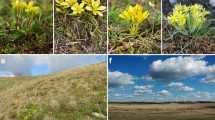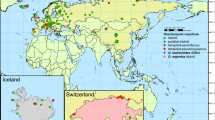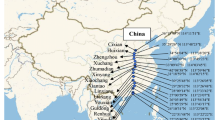Abstract
Belonging to the genus Cenchrus with 16–22 species, Cenchrus ciliaris L. (syn. Pennisetum ciliare (L.) Link, buffelgrass) is a perennial, common in warmer regions of both hemispheres, growing as a C4 grass in a wide range of habitats. In the present study we determined chromosome number and nuclear DNA content (2C DNA) for 28 natural populations collected from northern to southern Tunisia. Three ploidy levels were found: one tetraploid population (2n = 4x = 36), three pentaploid (2n = 5x = 45), and 24 hexaploid populations (2n = 6x = 54). The hexaploid chromosome number has already been reported for Tunisian populations of C. ciliaris but tetraploid and pentaploid (2n = 45) are new for this area. The tetraploid population was found in the semi-arid north; pentaploids were mostly on the northern side of the arid region, while the hexaploids were located mainly in the arid southern Tunisian and Saharan region. 2C DNA values, assessed using flow cytometry, correlated with chromosome counts. Nuclear DNA content ranged from 2C = 3.03 to 4.61 pg, revealing three ploidy levels corresponding to 4x, 5x, 6x, and mean 2C DNA amounts were of 3.03, 3.7 and 4.48 pg, respectively. Each cytotype produced viable pollen. Flow cytometric seed screening neither proved nor disproved apomixis. The most frequent hexaploid populations seem best adapted to arid conditions in southern Tunisia. The monoploid value, 1Cx, was constant. The existence of pentaploid cytotype suggests hybridization ability between tetraploids and hexaploids. It appears that polyploidization is the major evolutionary mechanism in the speciation of C. ciliaris.





Similar content being viewed by others
References
Alexander MP (1969) Differential staining of aborted and non-aborted pollen. Biotech Histochem 62:107–112
Arriaga L, Castellanos AE, Moreno E, Alarcocon J (2003) Potential ecological distribution of Alien invasive species and risk assessment: A case study of buffel grass in arid regions of Mexico. Conservation Biol 18:1504–1514
Aronson J, Floret C, Le Floc’h E, Ovalle C, Pontanier R (1993) Restoration and rehabilitation of degraded ecosystems in arid and semi-arid lands. II. Case studies in Southern Tunisia, Central Chile and Northern Cameroon. Restor Ecol 1:168–87
Bashaw EC (1962) Apomixis and sexuality in buffelgrass. Crop Sci 2:412–415
Bashaw EC, Hignight KW (1990) Gene transfer in apomictic Buffelgrass through fertilization of an unreduced egg. Crop Sci 30:571–575
Belkhodja K, Bortoli L, Cointepas JP, Dimanche P, Fournet A, Jaquinet JC, Mori A (1973) Carte pédologique de la Tunisie 1/500 000. Sol de Tunisie n°5. République Tunisienne, Ministère de l’Agriculture, Tunis
Bogdan AV (1977) Tropical pasture and fodder plants (Grasses and legumes). Longman, London
Bousquet B (1992) Guide des parcs nationaux d’Afrique (Afrique du Nord, de l’Ouest). Ed. Delachaux et Niestlé, Paris
Brandes A, Heslop-Harrison JS, Kamm A, Kubis S, Doudrick RL, Schmidt T (1997) Comparative analysis of the chromosomal and genomic organization of Ty1-copia-like retrotransposons in pteridophytes, gymnosperms and angiosperms. Pl Molec Biol 33:11–21
Bray RR (1978) Evidence for facultative apomixis in Cenchrus ciliaris. Euphytica 27:801–802
Burson BL, Hussey MA, Actkinson JM, Shafer GS (2002) Effect of pollination time on the frequency of 2n + n fertilization in apomictic Buffelgrass. Crop Sci 42:1075–1080
Chaieb M, Henchi B, Boukhris M (1996) Impact of clipping on root systems of 3 grasses species in Tunisia. J Range Managem 49:336–339
Clayton WD, Renvoize SA (1982) Cenchrus. In Polhill RM (ed) Flora of Tropical East Africa (part 3). A.A. Balkema, Rotterdam, pp 691–695
Clayton WD, Renvoize SA (1986) Genera Graminum: Grasses of the World. Kew Bulletin Additional Series 13, HMSO, London
Correll DS, Johnston MC (1970) Manual of the vascular plants of Texas. Texas Research Foundation, Renner, Texas
Crins WJ (1991) The genera of Paniceae (Gramineae: Panicoideae) in the Southeastern United States. J Arnold Arbor Suppl 1:205–220
Cuénod A, Pottier-Alapetite G, Labbe A (1954) Flore analytique et synoptique de la Tunisie : cryptogames vasculaires, gymnospermes et monocotylédones. SEFAN, Tunis
Daehler CC, Goergen EM (2005) Experimental restoration of an indigenous Hawaiian grassland after invasion by buffel grass (Cenchrus ciliaris). Restor Ecol 13:380–389
DeLisle DG (1963) Taxonomy and distribution of the genus Cenchrus. Iowa State J Sci 37:259–351
Doležel J, Bartoš J, Voglmayr H, Greilhuber J (2003) Nuclear DNA content and genome size of trout and human. Cytometry 51:127–128
Donadío S, Giussani LM, Kellogg EA, Zuloaga FO, Morrone O (2009) A preliminary molecular phylogeny of Pennisetum and Cenchrus (Poaceae-Paniceae) based on the trnL-F, rp116 chloroplast markers. Taxon 58:392–404
Fisher WD, Bashaw EC, Holt EC (1954) Evidence for apomixis in Pennisetum ciliare and Cenchrus setigerus. Agron J 46:401–404
Franklin KA, Lyons K, Nagler PL, Lampkin D, Glenn EP, Molina-Freaner F, Markow T, Huete AR (2006) Buffelgrass (Pennisetum ciliare) land conversion and productivity in the plains of Sonora, Mexico. Biol Conservation 127:62–71
Gagnieu A (1949) L’observation des chromosomes. SEDES, Paris
Galbraith D, Harkins K, Maddox J, Ayres N, Sharma D, Firoozabady E (1983) Rapid flow cytometric analysis of the cell cycle in intact plant tissues. Science 220:1049–1051
Geber G, Schweizer D (1987) Cytochemical hetero-chromatin differentiation in Sinapis alba (Cruciferae) using a simple air-drying technique for producing chromosome spreads. Pl Syst Evol 158:97–106
Gervais C, Trahan R, Moreno D, Drolet AM (1993) Le Phragmite australis au Québec: distribution géographiques, nombres chromosomiques et reproduction. Canad J Bot 71:1386–1393
Greilhuber J (2005) Intraspecific variation in genome size in angiosperms: Identifying its existence. Ann Bot (Oxford) 95:91–98
Hijmans RJ, Cameron SE, Parra JL, Jones PG, Jarvis A (2005) Very high resolution interpolated climate surfaces for global land areas. Int J Climatol 25:1965–1978
Jackson J (2005) Is there a relationship between herbaceous species richness and buffel grass (Cenchrus ciliaris)? Austral Ecol 30:505–517
Kharrat-Souissi A, Baumel A, Torre F, Juin M, Siljak-Yakovlev S, Roig A, Chaieb M (2011) New insights into the polyploid complex Cenchrus ciliaris L. (Poaceae) show its capacity for gene flow and recombination processes despite its apomictic nature. Austral J Bot 59:543–553
Le Houérou HN (1993) Grazing lands of the Mediterranean Basin. In Coupland RT (ed) Natural grasslands: Eastern Hemisphere. Elsevier, Amsterdam, pp 197–220
Leitch IJ, Bennett MD (2004) Genome downsizing in polyploidy plants. Biol J Linn Soc 82:651–663
Marie D, Brown SC (1993) A cytometric exercise in plant DNA histograms, with 2C values for seventy species. Biol Cell 78:41–51
Martel E, Poncet V, Lamy F, Siljak-Yakovlev S, Lejeune B, Sarr A (2004) Chromosome evolution of Pennisetum species (Poaceae): implications of ITS phylogeny. Pl Syst Evol 249:139–149
Matzk F, Meister A, Schubert I (2000) An efficient screen for reproductive pathways using mature seeds of monocots and dicots. Plant J 21:97–108
Mganga KZ, Musimba NKR, Nyangito MM, Nyariki DM, Mwang’ombe AW, Ekaya WN, Muiru WM, Clavel D, Francis J, Kaufmann R, Verhagen J, Muiru WM (2010) Dry matter yields and hydrological properties of three perennial grasses of semi-arid environment in east Africa. Afr J Pl Sci 4:135–141
Mnif L, Mseddi K, Chaieb M (2005) Cenchrus ciliaris L. en Tunisie aride: nombre chromosomiques, aptitudes germinatives et reproductives de quelques populations. Acta Bot Gallica 152:45–56
Mseddi K, Mnif L, Chaieb M, Neffati M, Roux M (2004) Aboveground phytomass productivity and morphologic variability of Tunisian populations of Cenchrus ciliaris L. Afr J Range Forage Sci 19:13–20
Mseddi K, Visser M, Neffati M, Reheul D, Chaieb M (2002) Seed and spike traits from remnant populations of Cenchrus ciliaris L. in South Tunisia: high distinctiveness, no ecotypes. J Arid Environm 50:309–324
Ozias-Akins P, Akiyama Y, Hanna WW (2003) Molecular characterization of the genomic region linked with apomixis in Pennisetum/Cenchrus. Funct Integr Genomics 3:94–104
Roux N, Tolaza A, Radecki Z, Zapata-Arias FJ, Doležel J (2003) Rapid detection of aneuploidy in Musa using flow cytometry. Pl Cell Rep 21:483–490
Sherwood RT, Young BA, Bashaw EC (1980) Facultative apomixis in buffelgrass. Crop Sci 20:375–379
Snyder LA, Alice RH, Warmke, HE (1955) The mechanisms of apomixis in Pennisetum ciliare. Bot Gaz 116:209–221
Stieber MT, Wipff JK (2003) Cenchrus L. In Barkworth ME et al. (eds) Flora of North America north of Mexico, vol. 25, Magnoliophyta: Commelinidae (in part): Poaceae, part 2. Oxford University Press, New York, Oxford, pp 529–535
Vielle JP, Burson BL, Bashaw EC, Hussey MA (1995) Early fertilization events in the sexual and aposporous egg apparatus of Pennisetum ciliare (L.) Link. Plant J 8:309–316
Vielle-Calzada JP, Nuccio ML, Budiman MA, Thomas TL, Burson BL, Hussey MA, Wing RA (1996) Comparative gene expression in sexual and apomitic ovaries of Pennisetum ciliaris (L.) Link. Pl Molec Biol 32:1085–1092
Visser N, Morris C, Hardy MB, Botha JC (2007) Restoring bare patches in the Nama-Karoo of Southern Africa. Afr J Range Forage Sci 24:87–96
Visser M, Mseddi K, Chaïeb M, Neffati M (2008) Assessing yield and yield stability of remnant populations of Cenchrus ciliaris L. in arid Tunisia: developing a blueprint for initiating native seed production. Grass Forage Sci 63:301–313
Warmke HE (1954) Apomixis in Panicum maximum. Amer J Bot 41:5–11
Watson L, Dallwitz MJ (1992) The grass genera of the world. CAB International, Wallingford
Wieners RR, Fei S, Johnson RC (2006) Characterization of a USDA Kentucky bluegrass (Poa pratensis L.) core collection for reproductive mode and DNA content by flow cytometry. Genet Res Crop Evol 53:1531–1541
Ziegler AD, Warren SD, Perry JL, Giambelluca TW (2000) Reassessment of revegetation strategies for Kaho’olawe Island, Hawai’i. J Range Managem 53:106–113
Acknowledgments
The authors gratefully acknowledge M. Bourge, O. Catrice and N. Maunoury for their technical support at the Imagif and IFR87/IBiSA cytometry facility and F. Pustahija and O. Robin for their assistance in cytogenetics. The authors are also indebted to the Ministry of Education and Science of Tunisia, CNRS (Centre National de la Recherche Scientifique) and Comité Mixte de Coopération Universitaire France-Tunisie (CMCU, project n° 09 G 0901) for their funding of this project.
Author information
Authors and Affiliations
Corresponding author
Rights and permissions
About this article
Cite this article
Kharrat-Souissi, A., Siljak-Yakovlev, S., Brown, S.C. et al. Cytogeography of Cenchrus ciliaris (Poaceae) in Tunisia. Folia Geobot 48, 95–113 (2013). https://doi.org/10.1007/s12224-012-9137-x
Received:
Revised:
Accepted:
Published:
Issue Date:
DOI: https://doi.org/10.1007/s12224-012-9137-x




